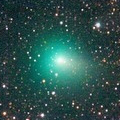
|
Now it is very bright as 9.0 mag (Apr. 30, Bob King). It stays observable in excellent condition for a while. But it will be fading after this, and it will fade down to 13 mag at the end of May.
Date(TT) R.A. (2000) Decl. Delta r Elong. m1 Best Time(A, h)
May 1 13 53.40 33 13.4 0.540 1.421 130 9.5 23:06 ( 0, 88)
May 8 12 29.76 30 42.7 0.709 1.497 120 10.4 21:20 ( 0, 85)
|
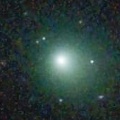
|
It brightened rapidly. Now it is very bright as 11.1 mag (Apr. 21, Osamu Miyazaki). It stays observable at 11 mag in good condition for a long time from spring to summer.
Date(TT) R.A. (2000) Decl. Delta r Elong. m1 Best Time(A, h)
May 1 13 45.87 32 23.3 1.424 2.222 131 11.3 23:07 ( 0, 87)
May 8 13 41.89 30 54.6 1.416 2.192 128 11.2 22:36 ( 0, 86)
|
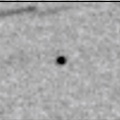
|
Now it is 11.2 mag (Apr. 19, Chris Wyatt). Appearing in the morning sky in the Southern Hemisphere. In the Northern Hemisphere, it will appear in the morning sky in June.
Date(TT) R.A. (2000) Decl. Delta r Elong. m1 Best Time(A, h)
May 1 0 23.09 -3 30.9 2.141 1.468 37 11.9 3:36 (271, -4)
May 8 0 43.30 -1 57.9 2.138 1.489 38 12.0 3:26 (270, -4)
|
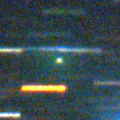
|
Now it is 13.1 mag (Apr. 22, Michael Jager). Brightenening very rapidly. It will brighten up to 11 mag from May to August. In the Southern Hemisphere, it stays observable in excellent condition for a long time. In the Northern Hemisphere, it stays observable in good condition for a while. But it becomes extremely low after July.
Date(TT) R.A. (2000) Decl. Delta r Elong. m1 Best Time(A, h)
May 1 19 31.54 4 0.3 0.580 1.275 103 12.8 3:36 (325, 54)
May 8 19 57.60 1 33.2 0.540 1.257 104 12.5 3:26 (324, 51)
|

|
Now it is 12.9 mag (Apr. 13, Thomas Lehmann). It will brighten up to 10 mag in winter in 2022. In the Northern Hemisphere, it stays observable in good condition for a long time, although it becomes extremely low temporarily from May to June. In the Southern Hemisphere, it is not observable until November.
Date(TT) R.A. (2000) Decl. Delta r Elong. m1 Best Time(A, h)
May 1 3 16.37 50 44.2 4.986 4.223 36 12.7 20:18 (144, 13)
May 8 3 29.94 50 39.0 4.986 4.190 34 12.7 20:26 (146, 11)
|
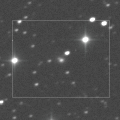
|
Now it is 12.9 mag (Apr. 19, Chris Wyatt). It stays 13 mag until early summer. In the Southern Hemisphere, it stays observable in good condition for a long time. It is getting higher slowly also in the Northern Hemisphere.
Date(TT) R.A. (2000) Decl. Delta r Elong. m1 Best Time(A, h)
May 1 16 8.33 -34 8.7 2.439 3.357 151 13.0 1:35 ( 0, 21)
May 8 15 48.68 -32 11.7 2.389 3.360 161 13.0 0:48 ( 0, 23)
|
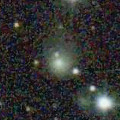
|
Now it is 13.2 mag (Apr. 21, Toshihiko Ikemura, Hirohisa Sato). It is expected to be observable at 5-6 mag for a long time from 2022 to 2023. In the Northern Hemisphere, it is not observable at the high light from 2022 summer to 2023 summer. In the Southern Hemisphere, it stays extremely low for a while. But it will be observable in good condition at the high light.
Date(TT) R.A. (2000) Decl. Delta r Elong. m1 Best Time(A, h)
May 1 18 21.28 42 1.0 6.192 6.485 102 13.1 3:36 (195, 83)
May 8 18 17.77 42 31.2 6.092 6.428 105 13.0 3:15 (180, 82)
|

|
It brightened up to 10.5 mag in early March (Mar. 8, Bob King). Now it is fading. But it is still bright as 12.6 mag (Apr. 4, Sandor Szabo). In the Northern Hemisphere, it stays observable in the evening low sky until early June while the comet will be fading. It is not observable in the Southern Hemisphere.
Date(TT) R.A. (2000) Decl. Delta r Elong. m1 Best Time(A, h)
May 1 4 51.34 34 1.6 2.075 1.401 36 13.5 20:18 (119, 18)
May 8 5 21.25 33 20.6 2.185 1.487 35 13.9 20:26 (119, 17)
|
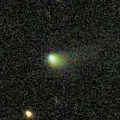
|
Now it is 14.4 mag (Apr. 19, Chris Wyatt). It stays 13-14 mag from 2020 to 2021. It will be observable in good condition after this in the Southern Hemisphere. It locates somewhat low in the Northern Hemisphere.
Date(TT) R.A. (2000) Decl. Delta r Elong. m1 Best Time(A, h)
May 1 19 24.65 -25 58.5 2.361 2.887 111 13.7 3:36 (341, 27)
May 8 19 27.68 -26 34.1 2.282 2.892 117 13.7 3:26 (345, 27)
|
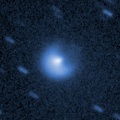
|
Now it is not observable. It will appear in the morning sky in July.
Date(TT) R.A. (2000) Decl. Delta r Elong. m1 Best Time(A, h)
May 1 3 19.41 26 23.9 6.839 5.876 15 13.9 20:18 (125, -2)
May 8 3 25.50 26 42.8 6.864 5.878 11 14.0 20:26 (130, -7)
|
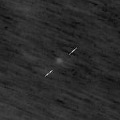
|
It will brighten up to 10 mag from summer to autumn, and it will be observable in excellent condition. Appearing in the morning sky.
Date(TT) R.A. (2000) Decl. Delta r Elong. m1 Best Time(A, h)
May 1 23 33.53 1 28.3 2.637 2.072 46 14.2 3:36 (274, 9)
May 8 23 48.65 2 55.3 2.548 2.032 48 14.0 3:26 (273, 10)
|

|
It brightened up to 11.6 mag in winter (Feb. 18, Thomas Lehmann). Now it is fading. It has already faded down to 14.3 mag (Apr. 30, Chris Wyatt). In the Southern Hemisphere, it stays observable in good condition after this. In the Northern Hemisphere, it will never be observable after this.
Date(TT) R.A. (2000) Decl. Delta r Elong. m1 Best Time(A, h)
May 1 4 20.81 -58 6.1 2.591 2.550 76 14.2 20:18 ( 39,-34)
May 8 4 28.62 -56 27.0 2.669 2.612 75 14.3 20:26 ( 42,-37)
|
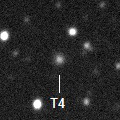
|
Now it is 14.5 mag (Apr. 30, Chris Wyatt). It is expected to brighten up to 11.5 mag in 2022. It is observable in excellent condition in the Southern Hemisphere. In the Northern Hemisphere, it is observable in the low sky until May.
Date(TT) R.A. (2000) Decl. Delta r Elong. m1 Best Time(A, h)
May 1 8 10.70 -29 9.8 5.230 5.371 92 14.2 20:18 ( 37, 15)
May 8 8 14.82 -28 12.2 5.267 5.337 88 14.2 20:26 ( 43, 12)
|
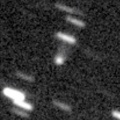
|
Now it is 14.9 mag (Apr. 19, Chris Wyatt). It was expected to brighten up to 13 mag from spring to summer. But actually, it is fainter than originally expected. It stays 14-15 mag until early autumn. In the Southern Hemisphere, it stays observable in good condition for a long time. In the Northern Hemisphere, it is not observable until July in 2022.
Date(TT) R.A. (2000) Decl. Delta r Elong. m1 Best Time(A, h)
May 1 20 21.74 -73 51.2 3.232 3.628 105 14.5 3:36 (351,-21)
May 8 20 41.27 -75 28.7 3.185 3.620 107 14.5 3:26 (351,-22)
|

|
It will brighten up to 14.5 mag from spring to summer. In the Southern Hemisphere, it stays observable in excellent condition for a long time. In the Northern Hemisphere, it is not observable after this.
Date(TT) R.A. (2000) Decl. Delta r Elong. m1 Best Time(A, h)
May 1 0 41.84 -55 15.2 2.741 2.648 74 14.8 3:36 (318,-32)
May 8 1 5.63 -57 44.5 2.663 2.651 78 14.8 3:26 (321,-34)
|
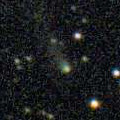
|
Now it is 14.9 mag (Apr. 18, Toshihiko Ikemura, Hirohisa Sato). It will stay at 14-15 mag for a long time from 2021 to 2022. It stays observable in good condition after this while brightening gradually.
Date(TT) R.A. (2000) Decl. Delta r Elong. m1 Best Time(A, h)
May 1 18 7.84 0 42.2 4.555 5.193 124 14.9 3:33 ( 0, 56)
May 8 18 2.50 0 18.1 4.452 5.179 131 14.9 3:00 ( 0, 55)
|

|
Now it is 15.3 mag (Apr. 19, Chris Wyatt). It stays 14-15 mag until the end of 2021. In the Southern Hemisphere, it stays observable in good condition for a long time. In the Northern Hemisphere, it is not observable until June.
Date(TT) R.A. (2000) Decl. Delta r Elong. m1 Best Time(A, h)
May 1 23 21.49 -37 32.3 4.594 4.337 69 15.0 3:36 (308,-12)
May 8 23 26.64 -36 54.9 4.517 4.342 73 15.0 3:26 (309,-10)
|

|
Now it is 15.6 mag (Apr. 12, Chris Wyatt). It stays 15 mag until summer. In the Southern Hemisphere, it stays observable in good condition until June. In the Northern Hemisphere, it is observable in the low sky from March to May.
Date(TT) R.A. (2000) Decl. Delta r Elong. m1 Best Time(A, h)
May 1 7 8.18 -15 31.9 2.209 2.170 74 15.1 20:18 ( 57, 16)
May 8 7 19.90 -11 48.3 2.250 2.136 70 15.1 20:26 ( 64, 15)
|

|
Now it is 14.9 mag (Apr. 18, Toshihiko Ikemura, Hirohisa Sato). It will brighten up to 13 mag in 2022. In 2021, it is observable at 15-16 mag in good condition.
Date(TT) R.A. (2000) Decl. Delta r Elong. m1 Best Time(A, h)
May 1 13 11.01 -0 3.1 2.704 3.641 154 15.3 22:32 ( 0, 55)
May 8 13 7.14 0 3.1 2.734 3.626 147 15.3 22:01 ( 0, 55)
|

|
Now it is 15.4 mag (Apr. 19, Toshihiko Ikemura, Hirohisa Sato). In the Northern Hemisphere, it stays observable for a long time while it is getting fainter slowly. In the Southern Hemisphere, it will never be observable again.
Date(TT) R.A. (2000) Decl. Delta r Elong. m1 Best Time(A, h)
May 1 14 43.67 69 11.8 5.590 5.779 95 15.5 0:09 (180, 56)
May 8 14 29.18 68 37.1 5.666 5.827 94 15.5 23:21 (180, 57)
|
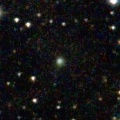
|
Now it is 16.1 mag (Apr. 20, Toshihiko Ikemura, Hirohisa Sato). In the Northern Hemisphere, it stays observable at 15-16 mag for a long time from spring to early 2022. In the Southern Hemisphere, it is not observable until the end of 2021.
Date(TT) R.A. (2000) Decl. Delta r Elong. m1 Best Time(A, h)
May 1 19 27.58 75 12.5 3.223 3.198 79 15.6 3:36 (187, 49)
May 8 18 47.61 77 53.0 3.194 3.175 79 15.5 3:26 (181, 47)
|

|
Now it is 15.8 mag (Jan. 16, Slooh.com Canary Islands Observatory). It is not observable until June.
Date(TT) R.A. (2000) Decl. Delta r Elong. m1 Best Time(A, h)
May 1 1 14.06 18 55.6 3.076 2.150 19 15.6 3:36 (246, -1)
May 8 1 28.46 20 48.5 3.068 2.164 21 15.7 3:26 (245, 1)
|

|
It had been observed as 8-9 mag for a long time in 2020. Now it is fading. It has already faded down to 16.4 mag (Mar. 27, Thomas Lehmann). It will be observable in good condition after this in the Southern Hemisphere. It locates extremely low after this in the Northern Hemisphere.
Date(TT) R.A. (2000) Decl. Delta r Elong. m1 Best Time(A, h)
May 1 17 31.79 -42 56.6 3.766 4.510 132 15.6 2:57 ( 0, 12)
May 8 17 25.55 -43 48.4 3.762 4.574 139 15.7 2:24 ( 0, 11)
|

|
It has not been observed yet in this apparition. The condition of this apparition is bad. It brightens up to 15.5 mag in spring, however, it is not observable until autumn when it becomes fainter than 19 mag.
Date(TT) R.A. (2000) Decl. Delta r Elong. m1 Best Time(A, h)
May 1 2 24.88 15 24.3 2.265 1.258 1 15.8 3:36 (237,-16)
May 8 2 50.25 17 41.9 2.247 1.239 2 15.7 3:26 (234,-16)
|
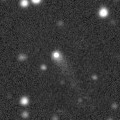
|
Now it is 15.7 mag (Apr. 4, Michael Jager). It stays observable at 16 mag from 2021 to 2022. Toshihiko Ikemura and Hirohisa Sato reported it was very bright as 14.2 mag on Apr. 19.
Date(TT) R.A. (2000) Decl. Delta r Elong. m1 Best Time(A, h)
May 1 13 58.66 -12 17.2 3.858 4.856 171 15.7 23:20 ( 0, 43)
May 8 13 54.32 -10 42.6 3.869 4.843 162 15.7 22:48 ( 0, 44)
|
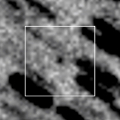
|
Brightening very rapidly. It will brighten up to 8.5 mag from September to October. But the condition is bad in this apparition. In the Northern Hemisphere, it is observable only in the extremely low sky until July. In the Southern Hemisphere, it will be observable after late August. But it stays locating low for a while.
Date(TT) R.A. (2000) Decl. Delta r Elong. m1 Best Time(A, h)
May 1 1 33.49 44 37.0 2.727 1.950 32 16.1 3:36 (223, 11)
May 8 1 57.66 45 6.5 2.670 1.877 30 15.7 3:26 (222, 11)
|

|
Now it is 17-17.5 mag (Apr. 10, Alan Hale), 14.5 mag (Apr. 12, Thomas Lehmann). It will brighten very rapidly, and it will brighten up to 10 mag from July to August. It stays observable in the morning sky for a long time.
Date(TT) R.A. (2000) Decl. Delta r Elong. m1 Best Time(A, h)
May 1 22 17.96 -18 1.9 1.388 1.423 70 16.4 3:36 (301, 11)
May 8 22 45.44 -15 26.7 1.308 1.360 70 15.7 3:26 (298, 11)
|
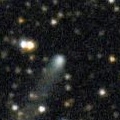
|
Now it is 16.1 mag (Apr. 20, Toshihiko Ikemura, Hirohisa Sato). It stays 15-16 mag until June. In the Northern Hemisphere, it stays observable in good condition for a long time. In the Southern Hemisphere, it will be observable in the extremely low sky only in next spring.
Date(TT) R.A. (2000) Decl. Delta r Elong. m1 Best Time(A, h)
May 1 19 7.24 48 15.4 5.012 5.152 92 15.8 3:36 (214, 73)
May 8 19 0.64 50 2.8 5.000 5.180 94 15.8 3:26 (198, 74)
|

|
It brightened up to 5.6 mag in early December (Dec. 9, Marco Goiato). In mid December, it was visible at about 3 mag in the SOHO spacecraft images (Dec. 18, Hirohisa Sato). Appearing in the morning sky.
Date(TT) R.A. (2000) Decl. Delta r Elong. m1 Best Time(A, h)
May 1 23 49.87 12 54.7 3.309 2.612 39 15.8 3:36 (262, 12)
May 8 23 56.40 13 51.9 3.339 2.707 44 15.9 3:26 (263, 15)
|
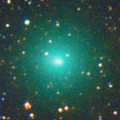
|
It brightened up to 8.2 mag in autumn (Oct. 13, Chris Wyatt). It faded down to 13.0 mag in February (Feb. 14, Sandor Szabo). It is not observable after this.
Date(TT) R.A. (2000) Decl. Delta r Elong. m1 Best Time(A, h)
May 1 2 26.21 13 24.6 3.490 2.483 2 15.8 3:36 (238,-18)
May 8 2 38.10 14 26.6 3.530 2.528 5 16.0 3:26 (239,-16)
|

|
Now it is 16.0 mag (Apr. 4, Michael Jager). Toshihiko Ikemura and Hirohisa Sato reported it was bright as 14.7 mag on Apr. 18. It is expected to brighten up to 13 mag in 2022. In the Southern Hemisphere, it stays observable in good condition for a long time. In the Northern Hemisphere, it stays observable until June, but it will not be observable at the high light.
Date(TT) R.A. (2000) Decl. Delta r Elong. m1 Best Time(A, h)
May 1 12 51.17 -20 52.6 4.002 4.935 155 15.9 22:12 ( 0, 34)
May 8 12 42.87 -20 48.1 4.008 4.889 147 15.9 21:37 ( 0, 34)
|
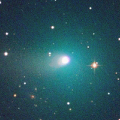
|
Brightened rapidly, and it brightened up to 9.7 mag in November (Nov. 15, Chris Wyatt). Now it is fading. It has already faded down to 14.9 mag (Apr. 4, Sandor Szabo). In the Northern Hemisphere, it stays observable in good condition for a long time. In the Southern Hemisphere, it locates extremely low after this.
Date(TT) R.A. (2000) Decl. Delta r Elong. m1 Best Time(A, h)
May 1 7 1.38 38 7.0 2.458 2.192 62 16.0 20:18 (112, 44)
May 8 7 18.31 37 18.4 2.573 2.243 59 16.3 20:26 (112, 40)
|
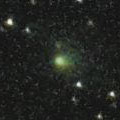
|
It brightened rapidly. Now it is bright as 15.5 mag (Apr. 5, Sandor Szabo). It will be fading after this, and it will be fainter than 18 mag in July.
Date(TT) R.A. (2000) Decl. Delta r Elong. m1 Best Time(A, h)
May 1 13 37.52 10 16.2 1.441 2.374 151 16.1 22:57 ( 0, 65)
May 8 13 10.32 7 56.2 1.497 2.383 143 16.2 22:03 ( 0, 63)
|
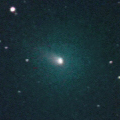
|
It brightening very rapidly up to 12.5 mag in early February (Feb. 8, Michael Jager). Now it is fading. It has already faded down to 14.9 mag (Apr. 12, Chris Wyatt). In the Southern Hemisphere, it stays observable after this while the comet will be fading. It is not observable after this in the Northern Hemisphere.
Date(TT) R.A. (2000) Decl. Delta r Elong. m1 Best Time(A, h)
May 1 4 15.24 -15 27.5 1.929 1.320 39 16.3 20:18 ( 83,-17)
May 8 4 16.93 -17 4.5 2.004 1.376 39 17.1 20:26 ( 86,-25)
|

|
Now it is 17.1 mag (Apr. 20, Toshihiko Ikemura, Hirohisa Sato). It is observable at 16.5 mag from spring in 2020 to summer in 2021.
Date(TT) R.A. (2000) Decl. Delta r Elong. m1 Best Time(A, h)
May 1 17 12.27 -15 20.8 4.013 4.843 141 16.4 2:38 ( 0, 40)
May 8 17 3.18 -15 52.3 3.956 4.859 150 16.4 2:01 ( 0, 39)
|

|
Now it is 16.5 mag (Apr. 20, Toshihiko Ikemura, Hirohisa Sato). It is observable at 16 mag from 2020 to 2021. In the Southern Hemisphere, it is not observable until summer.
Date(TT) R.A. (2000) Decl. Delta r Elong. m1 Best Time(A, h)
May 1 23 16.47 43 9.1 6.554 5.961 50 16.5 3:36 (237, 32)
May 8 23 18.04 43 23.7 6.511 5.965 53 16.5 3:26 (238, 35)
|
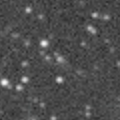
|
Now it is 16.6 mag (Apr. 21, Toshihiko Ikemura, Hirohisa Sato). It stays observable at 16.5-17 mag in good condition until October.
Date(TT) R.A. (2000) Decl. Delta r Elong. m1 Best Time(A, h)
May 1 17 28.59 -28 58.6 4.165 4.951 137 16.5 2:54 ( 0, 26)
May 8 17 24.55 -28 0.9 4.081 4.941 144 16.5 2:22 ( 0, 27)
|

|
First return of a new periodic comet which brightened up to 14-15 mag in 2006. Now it is 15.7 mag (Apr. 14, Toshihiko Ikemura, Hirohisa Sato). It will be fading rapidly after this, and it will be fainter than 18 mag in June.
Date(TT) R.A. (2000) Decl. Delta r Elong. m1 Best Time(A, h)
May 1 13 16.22 21 29.8 1.146 2.018 138 16.6 22:38 ( 0, 76)
May 8 13 16.80 20 53.9 1.217 2.055 134 16.8 22:11 ( 0, 76)
|
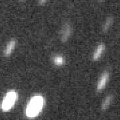
|
Now it is 17.0 mag (Apr. 1, Michael Jager). It is expected to brighten up to 11 mag in 2023. In the Northern Hemisphere, it stays observable in good condition for a long time. It locates extremely low in the Southern Hemisphere.
Date(TT) R.A. (2000) Decl. Delta r Elong. m1 Best Time(A, h)
May 1 18 17.40 47 58.6 6.638 6.879 99 16.7 3:36 (185, 77)
May 8 18 11.20 48 46.1 6.558 6.834 101 16.6 3:08 (180, 76)
|
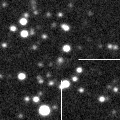
|
Now it is 16.3 mag (Apr. 19, Toshihiko Ikemura, Hirohisa Sato). It stays at 16-17 mag from 2020 to 2021. In the Northern Hemisphere, it stays observable in good condition for a long time. It locates extremely low in the Southern Hemisphere.
Date(TT) R.A. (2000) Decl. Delta r Elong. m1 Best Time(A, h)
May 1 19 45.38 43 49.4 8.804 8.825 87 16.7 3:36 (237, 70)
May 8 19 43.63 44 50.7 8.754 8.827 90 16.6 3:26 (230, 73)
|

|
It brightened up to 10.5 mag in early February (Feb. 6, Marco Goiato). Now it is fading rapidly. It has already faded down to 16.6 mag (Apr. 11, Toshihiko Ikemura, Hirohisa Sato). In the Northern Hemisphere, it stays observable for a long time after this. In the Southern Heimsphere, it will never be observable again.
Date(TT) R.A. (2000) Decl. Delta r Elong. m1 Best Time(A, h)
May 1 5 17.39 55 4.3 2.440 1.970 51 16.8 20:18 (138, 31)
May 8 5 24.64 56 19.3 2.569 2.035 47 17.2 20:26 (141, 28)
|
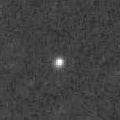
|
Now it is 17.0 mag (Apr. 11, Toshihiko Ikemura, Hirohisa Sato). It is expected to brighten up to 10 mag in 2023. In the Northern Hemisphere, it stays observable in good condition until 2023 autumn. In the Southern Hemipshere, it stays extremely low until mid July, then it becomes unobservable for a while. But it becomes observable in good condition after 2023 summer.
Date(TT) R.A. (2000) Decl. Delta r Elong. m1 Best Time(A, h)
May 1 12 24.34 38 51.3 6.863 7.395 118 16.9 21:46 (180, 86)
May 8 12 19.72 38 59.2 6.894 7.343 112 16.9 21:14 (180, 86)
|
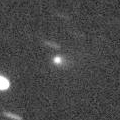
|
First return of a new periodic comet which brightened up to 16 mag in 2014. Now it is 16.0 mag (Apr. 4, Sandor Szabo). It stays observable at 16-17 mag in good condition until July.
Date(TT) R.A. (2000) Decl. Delta r Elong. m1 Best Time(A, h)
May 1 12 12.24 9 43.9 1.377 2.225 137 16.9 21:34 ( 0, 65)
May 8 12 9.71 8 33.4 1.415 2.211 130 16.9 21:04 ( 0, 63)
|
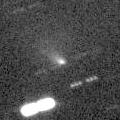
|
Now it is 17.0 mag (Apr. 14, Thomas Lehmann). It will be fading after this. In the Northern Hemisphere, it will be too low to observe in May. In the Southern Hemisphere, it stays observable in good condition after this.
Date(TT) R.A. (2000) Decl. Delta r Elong. m1 Best Time(A, h)
May 1 6 53.76 2 31.7 1.620 1.512 65 16.9 20:18 ( 74, 25)
May 8 7 15.72 0 37.1 1.693 1.564 65 17.1 20:26 ( 75, 22)
|

|
Now it is 16.7 mag (Apr. 11, Toshihiko Ikemura, Hirohisa Sato). It will be fading slowly.
Date(TT) R.A. (2000) Decl. Delta r Elong. m1 Best Time(A, h)
May 1 18 11.84 -15 33.2 6.903 7.556 127 17.0 3:36 ( 0, 39)
May 8 18 7.47 -15 10.7 6.834 7.580 134 17.0 3:05 ( 0, 40)
|
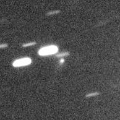
|
Now it is 16.7 mag (Apr. 19, Toshihiko Ikemura, Hirohisa Sato). It will approach to Earth down to 0.2 a.u. in December, and it is expected to brighten up to 4 mag. In the Northern Hemisphere, it stays observable in good condition for a long time until December while the comet is brightening gradually. In the Southern Hemisphere, it is not observable until mid December.
Date(TT) R.A. (2000) Decl. Delta r Elong. m1 Best Time(A, h)
May 1 11 31.92 61 24.5 3.581 3.815 95 17.1 20:53 (180, 64)
May 8 11 16.72 60 45.9 3.588 3.735 90 17.0 20:26 (175, 64)
|
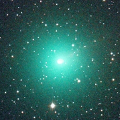
|
It brightened up to 7.3 mag in November (Nov. 7, Marco Goiato). Now it is fading. It has already faded down to 18.2 mag (Apr. 18, Toshihiko Ikemura, Hirohisa Sato). In the Northern Hemisphere, it stays observable in excellent condition for a long time. In the Southern Hemisphere, it stays locating extremely low after this.
Date(TT) R.A. (2000) Decl. Delta r Elong. m1 Best Time(A, h)
May 1 7 58.78 41 30.4 2.916 2.808 73 17.1 20:18 (114, 55)
May 8 8 10.49 40 40.9 3.068 2.880 69 17.4 20:26 (113, 51)
|

|
It will brighten up to 15 mag from summer to autumn, and it will be observable in good condition. It already locates high in the Southern Hemisphere. It will be getting higher gradually also in the Northern Hemisphere.
Date(TT) R.A. (2000) Decl. Delta r Elong. m1 Best Time(A, h)
May 1 21 53.50 -8 40.0 2.572 2.474 73 17.4 3:36 (298, 22)
May 8 22 3.94 -8 0.1 2.475 2.457 77 17.3 3:26 (299, 24)
|

|
Now it is 18.5 mag (Apr. 11, Taras Prystavski). It will brighten up to 9 mag, and will be observable in good condition in winter.
Date(TT) R.A. (2000) Decl. Delta r Elong. m1 Best Time(A, h)
May 1 22 40.46 -12 5.9 2.635 2.364 63 17.6 3:36 (293, 11)
May 8 22 52.34 -10 59.6 2.506 2.310 67 17.3 3:26 (293, 13)
|
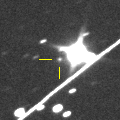
|
Now it is 17.1 mag (Apr. 11, Toshihiko Ikemura, Hirohisa Sato). It stays observable at 17-18 mag for a long time until 2024.
Date(TT) R.A. (2000) Decl. Delta r Elong. m1 Best Time(A, h)
May 1 15 4.55 -9 12.2 8.185 9.179 170 17.5 0:30 ( 0, 46)
May 8 14 59.97 -8 45.7 8.168 9.168 171 17.5 23:54 ( 0, 46)
|

|
Now it is 17.1 mag (Apr. 9, Toshihiko Ikemura, Hirohisa Sato). It brightened rapidly. It stays 17-18 mag for a long time from 2021 to 2022. In the Southern Hemisphere, it stays observable in good condition for a long time. In the Northern Hemisphere, it is observable only until May.
Date(TT) R.A. (2000) Decl. Delta r Elong. m1 Best Time(A, h)
May 1 8 15.87 -7 25.0 5.472 5.528 87 17.5 20:18 ( 50, 33)
May 8 8 15.53 -7 34.5 5.567 5.514 81 17.5 20:26 ( 57, 27)
|

|
Now it is 17.5 mag (Apr. 18, Toshihiko Ikemura, Hirohisa Sato). Fading slowly. In 2021, it stays observable at 17-18 mag in good condition until early summer.
Date(TT) R.A. (2000) Decl. Delta r Elong. m1 Best Time(A, h)
May 1 12 58.34 -15 17.1 6.063 7.003 157 17.6 22:20 ( 0, 40)
May 8 12 56.94 -14 42.3 6.123 7.019 150 17.7 21:51 ( 0, 40)
|

|
Now it is 17.6 mag (Apr. 11, Toshihiko Ikemura, Hirohisa Sato). It will brighten up to 16 mag in 2022. In 2021, it stays observable at 18 mag until September.
Date(TT) R.A. (2000) Decl. Delta r Elong. m1 Best Time(A, h)
May 1 13 31.93 3 56.2 2.438 3.382 155 17.7 22:53 ( 0, 59)
May 8 13 28.02 4 0.6 2.462 3.368 149 17.7 22:22 ( 0, 59)
|
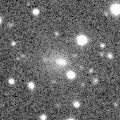
|
Brightened very rapidly up to 15.0 mag (Feb. 4, Michael Jager). Now it is fading. It hasl already faded down to 17.8 mag (Apr. 11, Toshihiko Ikemura, Hirohisa Sato). It is observable in good condition in the Northern Hemisphere. It locates low in the Southern Hemisphere.
Date(TT) R.A. (2000) Decl. Delta r Elong. m1 Best Time(A, h)
May 1 6 39.84 26 43.6 2.506 2.156 58 17.7 20:18 (100, 36)
May 8 6 55.84 26 10.3 2.599 2.187 55 17.9 20:26 (102, 31)
|

|
Now it is 17.1 mag (Apr. 18, Toshihiko Ikemura, Hirohisa Sato). It stays 17-18 mag for a long time from 2021 to 2023.
Date(TT) R.A. (2000) Decl. Delta r Elong. m1 Best Time(A, h)
May 1 10 36.64 12 13.0 4.362 4.882 115 17.7 20:18 ( 12, 67)
May 8 10 36.96 12 3.8 4.453 4.875 108 17.7 20:26 ( 32, 64)
|
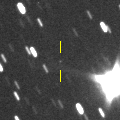
|
Now it is 19.3 mag (Apr. 11, Toshihiko Ikemura, Hirohisa Sato). It will brighten very rapidly, and it will be observable at 10 mag in good condition from October to December. In the Northern Hemisphere, it locates somewhat low at the high light.
Date(TT) R.A. (2000) Decl. Delta r Elong. m1 Best Time(A, h)
May 1 16 52.26 12 37.9 1.176 2.024 135 17.9 2:17 ( 0, 68)
May 8 16 51.06 14 7.1 1.102 1.975 138 17.7 1:49 ( 0, 69)
|
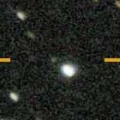
|
Now it is 17.5 mag (Apr. 11, Toshihiko Ikemura, Hirohisa Sato). It is expected to brighten up to 12 mag in 2023. In the Northern Hemisphere, it is observable in good condition in 2021. But it is observable only until November in 2022. In the Southern Hemisphere, it locates extremely low in 2021. But it will be observable in good condition at the high light.
Date(TT) R.A. (2000) Decl. Delta r Elong. m1 Best Time(A, h)
May 1 18 45.24 45 9.0 6.971 7.166 97 17.8 3:36 (210, 78)
May 8 18 42.34 45 35.4 6.878 7.118 99 17.7 3:26 (192, 79)
|
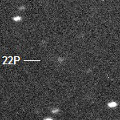
|
Now it is 18.0 mag (Apr. 18, Toshihiko Ikemura, Hirohisa Sato). It will be observable at 11 mag from winter to spring in 2022. In 2021, it is observable until July or August when it brightens up to 16-17 mag.
Date(TT) R.A. (2000) Decl. Delta r Elong. m1 Best Time(A, h)
May 1 10 18.82 14 58.9 2.634 3.133 110 17.8 20:18 ( 25, 68)
May 8 10 19.36 14 51.3 2.692 3.094 103 17.8 20:26 ( 43, 64)
|

|
It has not been observed yet in this apparition. It will brighten up to 15 mag from summer to autumn. In the Southern Hemisphere, it stays observable for a long time. In the Northern Hemisphere, it is not observable until late June. But it will be observable in good condition after that.
Date(TT) R.A. (2000) Decl. Delta r Elong. m1 Best Time(A, h)
May 1 0 29.22 -11 25.8 2.556 1.904 40 18.0 3:36 (277,-10)
May 8 0 45.62 -9 26.6 2.481 1.864 42 17.8 3:26 (275, -9)
|

|
First return of a new periodic comet observed at 17 mag in 2014. It has not been observed yet in this apparition. It is expected to brighten up to 17 mag from summer to autumn, and it will be observable in good condition.
Date(TT) R.A. (2000) Decl. Delta r Elong. m1 Best Time(A, h)
May 1 22 42.48 -6 48.6 1.988 1.740 61 17.9 3:36 (289, 14)
May 8 22 59.20 -4 33.3 1.925 1.723 63 17.8 3:26 (287, 16)
|

|
It has not been observed yet in this apparition. It will brighten up to 15.5 mag from summer to autumn. It stays observable for a long time.
Date(TT) R.A. (2000) Decl. Delta r Elong. m1 Best Time(A, h)
May 1 15 41.98 -16 16.5 1.289 2.272 163 18.2 1:08 ( 0, 39)
May 8 15 37.18 -15 45.5 1.234 2.236 170 17.9 0:35 ( 0, 39)
|
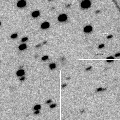
|
Now it is 18.2 mag (Apr. 19, Toshihiko Ikemura, Hirohisa Sato). In the Northern Hemisphere, it stays observable at 18 mag for a long time from 2021 to 2022. It is not observable in the Southern Hemisphere.
Date(TT) R.A. (2000) Decl. Delta r Elong. m1 Best Time(A, h)
May 1 17 57.20 52 27.7 6.847 7.082 99 17.9 3:22 (180, 73)
May 8 17 49.61 53 27.6 6.826 7.082 100 17.9 2:47 (180, 72)
|
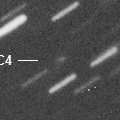
|
Now it is 17.5 mag (Mar. 15, Giuseppe Pappa). It is observable at 18 mag in spring. It is observable in excellent condition in the Southern Hemisphere. It locates low in the Northern Hemisphere.
Date(TT) R.A. (2000) Decl. Delta r Elong. m1 Best Time(A, h)
May 1 13 10.93 -32 9.9 3.652 4.583 154 17.9 22:32 ( 0, 23)
May 8 13 1.74 -30 5.5 3.691 4.593 150 18.0 21:55 ( 0, 25)
|

|
Now it is 18.6 mag (Apr. 4, Michael Jager). Although it is around the aphelion, it is much brighter than originally predicted.
Date(TT) R.A. (2000) Decl. Delta r Elong. m1 Best Time(A, h)
May 1 10 43.34 10 38.3 4.873 5.416 117 18.4 20:18 ( 8, 65)
May 8 10 42.70 10 31.9 4.976 5.418 110 18.5 20:26 ( 27, 63)
|
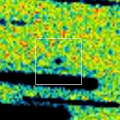
|
It was expected to brighten up to 13 mag from spring to summer. But actually, it is extremely faint as 19.0 mag (Mar. 22, A. C. Gilmore, P. M. Kilmartin). In the Southern Hemisphere, it stays observable in good condition for a long time. In the Northern Hemisphere, it is not observable until late August.
Date(TT) R.A. (2000) Decl. Delta r Elong. m1 Best Time(A, h)
May 1 23 46.19 -45 52.2 1.619 1.613 71 18.4 3:36 (312,-20)
May 8 0 29.83 -46 24.3 1.578 1.586 71 18.5 3:26 (311,-24)
|
|
![]()
 C/2020 H6 ( ATLAS )
C/2020 H6 ( ATLAS ) 8P/Tuttle
8P/Tuttle 15P/Finlay
15P/Finlay C/2019 K7 ( Smith )
C/2019 K7 ( Smith ) C/2020 S3 ( Erasmus )
C/2020 S3 ( Erasmus ) 88P/Howell
88P/Howell C/2020 Y2 ( ATLAS )
C/2020 Y2 ( ATLAS ) 156P/Russell-LINEAR
156P/Russell-LINEAR C/2020 S8 ( Lemmon )
C/2020 S8 ( Lemmon ) C/2021 A4 ( NEOWISE )
C/2021 A4 ( NEOWISE ) C/2017 Y2 ( PanSTARRS )
C/2017 Y2 ( PanSTARRS ) C/2019 T3 ( ATLAS )
C/2019 T3 ( ATLAS ) C/2020 O2 ( Amaral )
C/2020 O2 ( Amaral ) 409P/2020 V1 ( LONEOS-Hill )
409P/2020 V1 ( LONEOS-Hill ) C/2019 U5 ( PanSTARRS )
C/2019 U5 ( PanSTARRS ) C/2019 O3 ( Palomar )
C/2019 O3 ( Palomar ) C/2021 A2 ( NEOWISE )
C/2021 A2 ( NEOWISE ) C/2020 V2 ( ZTF )
C/2020 V2 ( ZTF ) 413P/2020 W4 ( Larson )
413P/2020 W4 ( Larson ) C/2020 N1 ( PanSTARRS )
C/2020 N1 ( PanSTARRS ) C/2017 U7 ( PanSTARRS )
C/2017 U7 ( PanSTARRS ) C/2021 A1 ( Leonard )
C/2021 A1 ( Leonard ) C/2020 M3 ( ATLAS )
C/2020 M3 ( ATLAS ) 284P/McNaught
284P/McNaught 67P/Churyumov-Gerasimenko
67P/Churyumov-Gerasimenko C/2020 F2 ( ATLAS )
C/2020 F2 ( ATLAS ) C/2020 F7 ( Lemmon )
C/2020 F7 ( Lemmon ) C/2019 C1 ( ATLAS )
C/2019 C1 ( ATLAS ) 152P/Helin-Lawrence
152P/Helin-Lawrence P/2020 U2 ( PanSTARRS )
P/2020 U2 ( PanSTARRS ) 99P/Kowal 1
99P/Kowal 1 6P/d'Arrest
6P/d'Arrest C/2020 K1 ( PanSTARRS )
C/2020 K1 ( PanSTARRS ) 22P/Kopff
22P/Kopff 106P/Schuster
106P/Schuster P/2014 W12 ( Gibbs )
P/2014 W12 ( Gibbs ) 57P/du Toit-Neujmin-Delporte
57P/du Toit-Neujmin-Delporte C/2016 Q2 ( PanSTARRS )
C/2016 Q2 ( PanSTARRS ) C/2021 C4 ( ATLAS )
C/2021 C4 ( ATLAS ) 47P/Ashbrook-Jackson
47P/Ashbrook-Jackson C/2020 K5 ( PanSTARRS )
C/2020 K5 ( PanSTARRS )![]()

























































